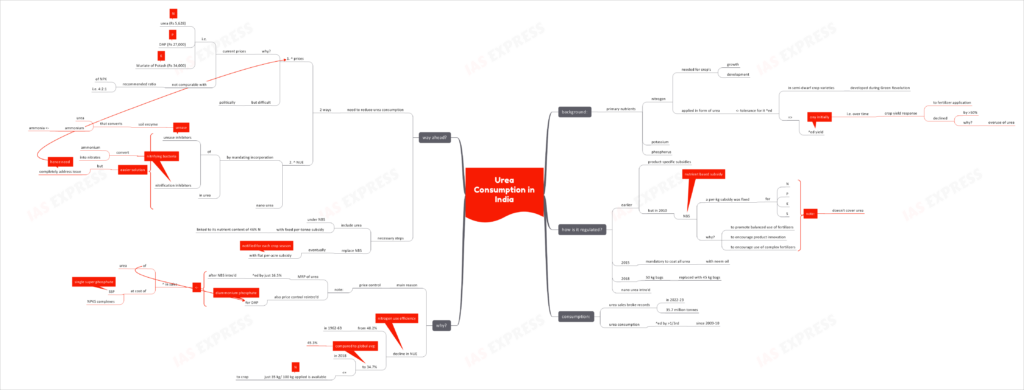Urea Consumption in India- Background, Reasons & Solutions

The recent numbers on urea consumption showed rampant overuse of this nitrogen-based fertilizer. This trend of fertilizer over-application continues despite government measures like mandatory neem oil coating of urea.

Background:
- Nitrogen is one of the primary nutrients needed for crops, the other two being potassium and phosphorus. Sufficient nitrogen is needed for plant growth and development.
- Urea is an important nitrogen-based fertilizer used in agricultural fields across India.
- During the Green revolution, semi-dwarf crop varieties were developed with higher ‘tolerance’ for fertilizer application. While these varieties initially helped boost yield, the crop yield response to fertilizer use has declined by more than half, over time.
- One of the key reasons for this is the disproportionate application of N-fertilizers.
How is government regulating fertilizer use?
- Earlier, the government provided product-specific subsidies. In 2010, the Nutrient-based Subsidy (NBS) Scheme was launched. Under this, a per-kg subsidy was fixed for each nutrient in the fertilizer- nitrogen, phosphorus, potash and sulphur.
- This was done to promote balanced use of fertilizers.
- It was expected to encourage product innovation.
- It was also expected to encourage use of complex fertilizers.
- Notably, NBS doesn’t cover urea.
- In 2015, the government made it mandatory to coat all urea with neem oil.
- In 2018, the government replaced the 50 kg urea bags with 45 kg bags.
- Nano urea has been introduced.
How much urea is being consumed?
- Despite these measures, the fertilizer consumption data paints a picture of worsening nutrient imbalance.
- In 2022-23, urea sales broke records by crossing 35.7 million tonnes.
- Urea consumption has increased by >1/3rd since 2009-10.
Why has this happened?
- Price control is a major reason for this trend. For instance, the MRP of urea went up by a mere 16.5% after the NBS regime was brought in.
- Last year, the government reintroduced price controls even on DAP (diammonium phosphate). This contributed to a significant increase in sale of both urea and DAP- at the cost of single super phosphate (SSP) and NPKS complexes.
- There has been a decline in NUE (Nitrogen Use Efficiency) from 48.2% in 1962-63 to 34.7% in 2018. In comparison, the global average is 45.3%. This means that hardly 35 kg of the total 100 kg of N being applied to a field is actually available to the crop.
What is the way ahead?
- There is a pressing need to cut down urea consumption. This can be done through 2 ways:
- Increasing urea prices:
- The current per-tonne prices of urea (Rs 5,628), DAP (Rs 27,000) and Muriate of Potash (Rs 34,000) aren’t compatible with the recommended NPK ratio of 4:2:1.
- However, hiking urea prices is a politically difficult move.
- Improving NUE:
- This can be achieved by mandating incorporation of urease and nitrification inhibitors in urea. These are compounds used to inhibit the activity of urease (an enzyme in the soil that breaks down urea into ammonium and eventually into ammonia) and nitrifying bacteria (microbes that convert ammonium into nitrates). This would make more N available to the plants.
- Use of innovative products like nano urea.
- Increasing urea prices:
- However, while the second option is the easier solution, it cannot completely address the rampant urea overuse. Raising the urea MRP is the need of the hour.
- NBS failed to address the issue only because it didn’t cover urea. Hence, urea must be brought under it ambit. A fixed per-tonne subsidy linked to its nutrient content of 46% N could be considered.
- Eventually, even the NBS regime must be replaced by a flat per-acre subsidy that’s notified for each crop season. This would prevent penalization of farmers who cultivate multiple crops in a year, while being judicious in fertilizer use.
Conclusion:
The recent record breaking overuse of urea is harming India’s soil and agricultural productivity. There are several ways India can reduce its urea use, with the most readily usable ones focusing on boosting NUE. However, to address the issue in its entirety, underpricing of urea must be dealt with.
Practice Question for Mains:
Comment on the issue of urea overuse in India. What needs to be done to cut down urea consumption? (250 words)
If you like this post, please share your feedback in the comments section below so that we will upload more posts like this.

